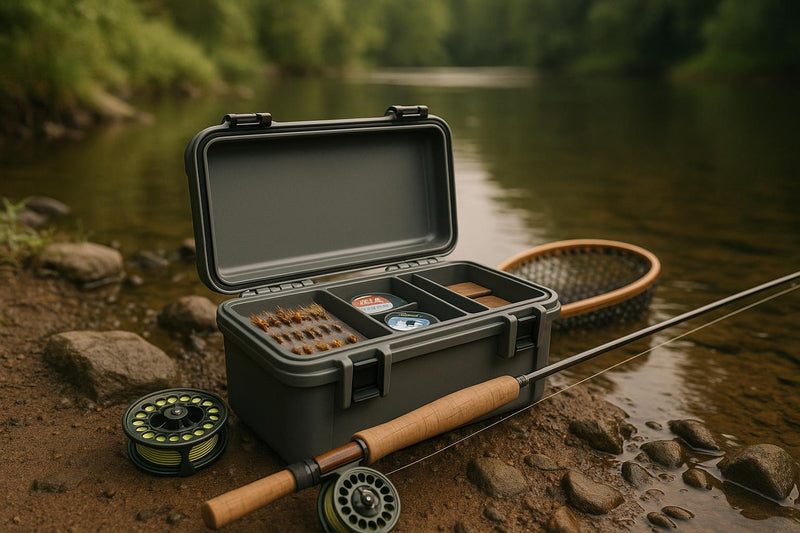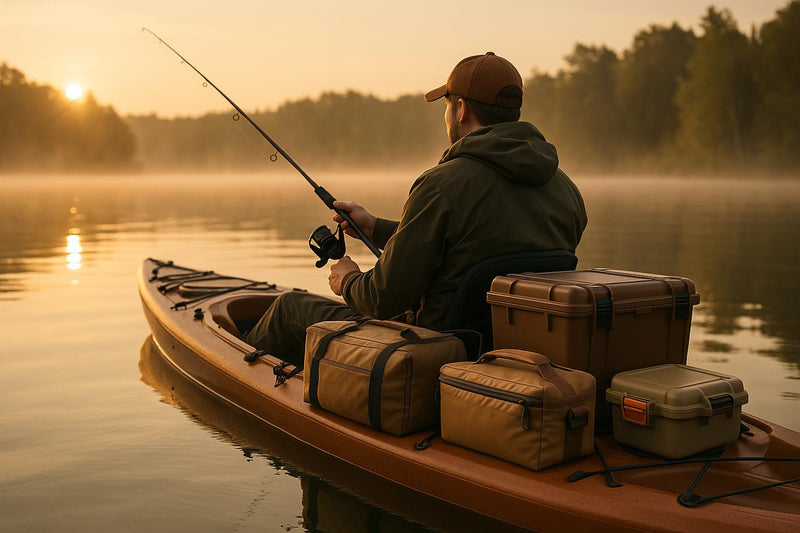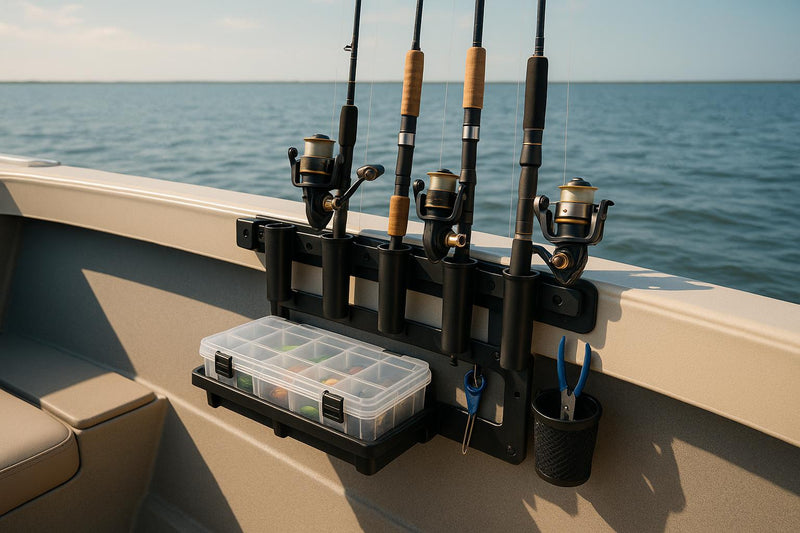Keeping your fishing gear dry is critical for a hassle-free experience. Waterproof storage solutions protect your equipment from water, dust, temperature changes, and even pests. Here's what you need to know:
- Types of Storage: Options include hard-shell tackle boxes, soft waterproof bags, backpacks, and binders for soft plastics.
- Materials: Look for high-density plastics, marine-grade metals, treated fabrics, and welded seams for durability and water resistance.
- Features: Roll-top closures, waterproof zippers, and modular compartments help keep gear organized and dry.
- Maintenance: Rinse with fresh water after saltwater trips, dry thoroughly, and store in stable, climate-controlled environments to prevent damage.
Whether you're fishing in rain, saltwater, or rugged terrain, the right waterproof storage ensures your gear stays protected and ready for action. From compact fly boxes to heavy-duty duffel bags, there's a solution for every angler's needs.
Materials Used in Waterproof Fishing Storage
The performance of waterproof fishing storage hinges on the materials it's made from. Each material offers distinct levels of protection, durability, and usability, making it essential to know which ones suit your fishing conditions best.
High-Density Plastics and Marine-Grade Metals
High-Density Polyethylene (HDPE) is a go-to choice for hard-shell waterproof storage. It's highly resistant to impacts, UV rays, and chemical corrosion, even in extreme temperatures. HDPE tackle boxes can survive significant drops and prolonged exposure to saltwater without cracking, ensuring your gear stays safe and dry.
Polycarbonate is another popular material, especially for smaller containers like fly boxes. Its clear finish lets you see your gear without opening the box, while maintaining a waterproof seal.
Marine-grade aluminum, particularly alloys like 5086 and 6061, is lightweight and resists saltwater corrosion. An anodized coating adds an extra layer of protection, making it ideal for harsh environments.
For hardware such as hinges, latches, and screws, 316-grade stainless steel stands out. Its molybdenum content provides excellent resistance to chloride, ensuring durability in salty conditions.
Rotomolded plastic is a standout for its seamless, one-piece construction. This design resists water penetration and can endure heavy use, making it a favorite for rugged storage needs.
Treated Fabrics and Quick-Dry Materials
Soft waterproof storage solutions rely on advanced fabrics that combine water resistance, breathability, and durability. Thermoplastic polyurethane (TPU) coatings, for instance, create waterproof barriers on fabric surfaces without adding unnecessary weight or bulk.
Ripstop nylon with waterproof coatings prevents tears from spreading. Its durability is rated by denier (from 210D to 840D), with higher numbers offering greater strength.
For an eco-friendlier option, polyurethane-laminated, PVC-free fabrics provide excellent waterproofing while reducing environmental impact.
Quick-dry fabrics, often used in Fishing shorts and Men’s Fishing Shorts, wick away moisture and dry fast, preventing humidity that could harm your gear.
Durable water repellent (DWR) treatments make water bead and roll off fabric surfaces. However, they wear off over time and require reapplication. Many manufacturers now use C6 fluorocarbon-free DWR, offering effective water repellency with less environmental harm.
Welded seams are another key feature in fabric-based storage. Unlike sewn seams, welded seams eliminate water entry points. High-frequency welding creates bonds stronger than the material itself, ensuring long-lasting waterproof performance.
For storage that needs ventilation while staying water-resistant, microporous membranes are a smart choice. These membranes allow air to circulate while blocking liquid water, preventing condensation inside storage compartments - especially useful for items that generate moisture or require air circulation.
Portability is another factor, especially for mobile anglers. Silnylon (silicone-impregnated nylon) offers a great balance of strength and light weight, though it demands careful handling to maintain its waterproofing. Dyneema composite fabrics are even lighter and more tear-resistant but come with a higher price tag.
Types of Waterproof Fishing Storage
When it comes to keeping your fishing gear safe and dry, the right waterproof storage can make all the difference. Choosing the best option depends on your gear, fishing style, and the conditions you’ll face. Let’s dive into the different types of waterproof storage, from compact tackle solutions to heavy-duty bags for extended trips.
Waterproof Tackle Boxes
Hard-shell tackle boxes are a go-to for securing hooks, lures, and small accessories. These boxes typically feature gasket-sealed lids paired with compression latches to create a watertight seal. Some models even go a step further with individually sealed compartments, ensuring that water doesn’t spread if one section is compromised.
Fly boxes, often made from clear polycarbonate, are another excellent option. They use silicone gaskets and magnetic closures, allowing you to see your flies at a glance without opening the box. This design keeps your flies secure and dry, even in rainy or damp conditions.
For added versatility, utility boxes with adjustable dividers are a great choice. Many feature a tongue-and-groove sealing system, where the lid fits snugly into a channel lined with a rubber gasket. This design evenly distributes pressure, enhancing the waterproof barrier.
If you’re fishing in saltwater, opt for tackle boxes made with corrosion-resistant materials and durable hardware to withstand the harsh environment.
Now, let’s shift to portable options like waterproof bags and backpacks.
Waterproof Bags and Backpacks
Dry bags are a simple yet effective solution. They use roll-top closures that create a waterproof seal with multiple folds. Rolling the top several times before fastening ensures your gear stays completely dry, even in heavy rain or splashes.
Waterproof backpacks take things up a notch with welded seams and specialized zippers. These zippers often feature polyurethane-coated teeth and sealed tape, making them both durable and easy to access. For kayak anglers or those expecting full submersion, submersible backpacks are a game-changer. They include features like pressure-release valves and sturdy buckle systems to handle water pressure changes, keeping your gear safe even when dunked.
Sizes vary widely, from compact 10-liter day packs to spacious 65-liter expedition bags. For most anglers, a 20-liter pack is perfect for day trips, while 35-liter options work well for overnight stays. Many designs also include external attachment points for wet or bulky items you’d rather keep separate.
For larger storage needs, waterproof duffel bags are ideal. Their cylindrical shape reduces stress on seals, while features like reinforced grab handles and removable shoulder straps add convenience. These bags are particularly handy for boat fishing or use as a base camp storage solution.
Next, let’s explore soft plastic systems designed for delicate items like rubber baits.
Soft Plastic Binders and Wraps
Soft plastic storage systems are perfect for organizing and protecting rubber baits. Polypropylene binders with individual sleeves keep baits separated and easy to identify. This setup not only simplifies organization but also prevents baits from sticking together.
For a more compact option, soft plastic wraps are a solid choice. These wraps use heat-sealed edges and resealable strips, much like food storage bags, to keep contents secure. This design helps prevent issues like plasticizer migration, which can degrade bait quality over time.
Tube-style containers are another practical option, especially for stick baits or live worms. These containers typically feature screw-on caps with O-ring seals and ventilation systems. The ventilation helps manage moisture while ensuring live bait stays properly hydrated.
For anglers who prefer a streamlined approach, modular soft plastic systems allow for color-coding and clear labeling, making it easier to grab the right bait quickly. Minimizing air exposure is key in all these systems to maintain the quality and longevity of your gear.
Whether you’re using tackle boxes, waterproof bags, or soft plastic storage, managing moisture effectively is crucial to keeping your equipment in top shape.
And if you’re looking for on-the-go storage that’s as functional as it is comfortable, check out Reel Comfort’s Fishing shorts. These Mens Fishing Shorts come with removable thigh pads for rod support, quick-drying water-resistant fabric, and plenty of storage pockets - making them a perfect addition to your waterproof setup.
Customizable Waterproof Storage Options
Every angler has their own approach to fishing, which means one-size-fits-all storage often falls short. Customizable waterproof storage systems allow you to tailor your gear organization to fit your fishing style, target species, and techniques. These systems not only save time by keeping everything organized but also offer more flexibility than traditional rigid options. Let’s dive into some modular and on-person storage solutions that can adapt to your needs.
Modular Compartments and Adjustable Dividers
For anglers who switch between species or techniques, modular tackle systems are a game-changer. These setups use interlocking trays and boxes that stack together, letting you create a personalized storage system. You can mix and match components depending on what your trip requires.
Most modular designs include removable dividers that slide into grooved channels, allowing you to create custom-sized compartments. Whether you need space for tiny jig heads or oversized swimbaits, these dividers lock into place, keeping everything secure during transport.
Some systems take it a step further with adjustable compartments. These use movable walls that slide along tracks, offering even more customization. Many include foam inserts you can trim to fit specific lure shapes, making them ideal for protecting expensive baits.
Fly anglers, on the other hand, often turn to magnetic foam systems. These feature thin magnetic sheets covered with foam that securely holds flies in place. The foam can be cut into any configuration, and the magnetic backing ensures your flies stay put, even if the box gets bumped.
One of the biggest perks of modular systems is their scalability. Start small and expand as your tackle collection grows. Some even include color-coding options, allowing you to sort gear by technique, season, or water type. For added convenience, stackable utility boxes with gasket seals are another great choice. These boxes nest together when not in use, saving space, and can be mounted to various tackle bag setups for easy transport.
On-Person Storage Solutions
Customizable internal systems are great, but portable on-person storage takes convenience to another level. Keeping essential gear within reach means less time rummaging through bags and more time focused on fishing.
Chest packs are perfect for wade fishing or any situation where hands-free mobility is a must. They typically feature multiple zippered compartments with welded seams and waterproof zippers. Waist packs offer a slimmer alternative, staying out of the way while casting. These often include quick-release buckles and attachment points for tools you use frequently.
For a more integrated approach, specialized fishing apparel can be incredibly handy. Take Reel Comfort's Fishing Shorts, for example. These Mens Fishing Shorts combine water-resistant fabric with strategically placed pockets to keep small essentials dry and easy to access. Plus, their quick-dry material ensures comfort in wet conditions, and the removable thigh pads offer extra support during long fishing sessions.
Pocket organizers are another smart option. These slim, flexible pouches slip into your existing pockets, creating waterproof compartments for items like licenses, phones, or small tackle. They’re great for anglers who want extra protection without changing their usual setup.
Lanyard systems also shine when it comes to tool storage. Modern designs often feature retractable tethers and magnetic breakaways, keeping tools like pliers or line cutters secure yet easily accessible. Pair these with tool holsters for even more convenience.
The biggest advantage of on-person storage is accessibility. When fish are actively feeding, having your gear at your fingertips can be the difference between landing a trophy catch or watching it swim away. Whether you’re a bank angler who prefers a larger waist pack or a kayak fisherman who needs chest-mounted storage, there’s a solution to match your style. For wading anglers, lightweight options that minimize drag in the current are often the best choice.
sbb-itb-cb0a783
Maintenance and Care for Waterproof Storage
Investing in quality waterproof storage is a smart move, but keeping it in good condition requires consistent care. With proper maintenance, you can ensure your gear stays reliable for years to come. Here’s how you can keep your equipment in top shape.
Cleaning and Drying
Salt water can wreak havoc on your gear. After any saltwater trip, rinse your storage containers thoroughly with fresh water, paying extra attention to zippers, latches, and gasket seals. Salt buildup can corrode seals and metal components once the water evaporates.
For routine cleaning, stick to warm water and mild dish soap. Avoid harsh detergents or bleach, as they can degrade rubber seals and waterproof coatings. A soft-bristled toothbrush is great for scrubbing zipper tracks and latch mechanisms.
Drying is just as important as cleaning. Never store wet items in closed containers, as this creates the perfect environment for mold and mildew. After cleaning, leave compartments open and allow them to air dry for 24–48 hours. For fabric bags, use paper towels to absorb moisture, replacing them as needed.
For fabric-based storage like tackle bags and backpacks, turn them inside out when possible and stuff them with newspaper or paper towels to absorb moisture in hard-to-reach areas.
Zippers require extra attention since they’re often the first part to fail. After cleaning, move the zippers back and forth while they’re still damp to clear out debris. Once dry, apply a thin layer of zipper lubricant or even rub a bar of soap along the teeth to keep them working smoothly.
Climate Control for Long-Term Storage
Extreme temperature changes can damage seals over time. Storing your waterproof gear in places like garages or attics exposes it to fluctuating temperatures, which can cause materials to expand and contract, eventually leading to cracks and weakened waterproofing.
To maintain your gear’s integrity, store it in a stable environment with temperatures between 50–70°F and a relative humidity of 30–50%. A climate-controlled closet or spare room works well, but avoid areas prone to flooding or excessive moisture, like basements without proper ventilation.
Keep your gear out of direct sunlight during storage. UV rays can degrade plastics and rubber over time, making them brittle and prone to cracks. If sunlight exposure is unavoidable, use opaque storage bins or cover your items with a dark cloth to block UV rays.
For hard cases and tackle boxes, store them slightly open to allow air circulation. Sealing them completely can create pressure buildup that stresses gaskets. Adding a small silica gel packet inside each container can help absorb any residual moisture.
Fabric storage items, like backpacks or soft tackle bags, should be loosely stuffed with acid-free tissue paper to help them retain their shape. Avoid compressing or folding them in the same spots repeatedly, as this can create creases that compromise waterproofing.
Preventing Moisture Buildup
Regular inspections can save you from costly repairs. Check seals, gaskets, and zippers at least once a month during the fishing season. Look for signs of wear, such as cracking, hardening, or discoloration in rubber components. Small issues can often be fixed with seal conditioner or replacement parts.
Rotate your gear periodically, even during the off-season. Take everything out every few months, inspect it, and rearrange how it’s stored. This prevents permanent compression marks and helps you spot any moisture problems early.
Condensation can be a hidden enemy. When cold gear is brought into a warm environment, leave containers open until they reach room temperature. Sealing cold gear in warm conditions traps condensation inside - something you definitely want to avoid.
A small hygrometer can help you monitor humidity levels in your storage area. If humidity consistently exceeds 60%, invest in a dehumidifier or move your gear to a drier location. High humidity accelerates corrosion on metal parts and encourages mold growth.
For frequent anglers, having backup storage is a game-changer. While one set of gear dries completely, you can use another for your next trip. Pairing this approach with quick-dry clothing like Fishing shorts and Mens Fishing Shorts ensures you’re always ready for the water.
Keeping a maintenance log for your high-value items is a smart habit. Note when you clean, inspect, and service each piece. Not only does this help you stay organized, but it can also be crucial if you need to make a warranty claim, as many manufacturers require proof of proper care.
Choosing the Right Waterproof Storage
Finding the perfect waterproof storage starts with understanding your fishing habits and the environment you’ll be in. For saltwater anglers, extra protection against salt-induced corrosion is essential. Think about how often you fish, the conditions you face, and the amount of gear you typically carry. From there, weigh factors like budget, size, and materials to match your specific needs.
When it comes to budget, it’s worth investing in durable storage with a solid warranty. A good warranty often reflects the manufacturer’s confidence in their waterproof technology and can save you from costly replacements down the line.
Size is another critical factor. Measure your essential gear and choose storage that prevents items from shifting or being overly compressed, while leaving room for future additions. This ensures your equipment stays organized and protected.
Material choice should align with your fishing style. Hard cases are ideal for boat fishing, offering sturdy protection, while soft bags work well for wading due to their flexibility. For those who need versatility, modular systems can adapt to various setups. Don’t overlook integrated gear storage, either. High-quality Fishing shorts made with water-resistant fabric and secure pockets can keep essentials like pliers, line, and small lures within easy reach, even in wet conditions. Many anglers also value the durability and thoughtful design of Mens Fishing Shorts for all-day comfort on the water.
Climate plays a big role in your decision, too. In hot and humid environments, look for storage with ventilation features to reduce condensation. In colder climates, choose materials that stay flexible and resist cracking. Additionally, if you’re fishing in areas with high UV exposure, opt for storage that resists sun damage. Making smart choices now not only protects your gear but also cuts down on future maintenance and replacement costs.
Before heading out, test any waterproof storage you plan to use. Submerge an empty container for about 30 minutes to check its seals, paying close attention to zippers and seams, as these are common weak points. Pairing reliable storage with on-person solutions like Reel Comfort’s Fishing shorts and Mens Fishing Shorts ensures your gear stays secure and accessible, creating the ultimate fishing setup.
FAQs
What’s the difference between hard-shell tackle boxes and soft waterproof bags for fishing gear?
Hard-shell tackle boxes are made from sturdy materials like plastic or metal, offering strong protection and built-in compartments to keep your gear neatly organized. That said, they can be bulky and harder to carry, especially on longer trips.
Soft waterproof bags, by contrast, are lightweight and flexible, often featuring shoulder straps for easier carrying. They’re great for mobility and provide water resistance, but they might not offer the same level of protection or detailed organization as their hard-shell counterparts.
The choice really depends on what matters most to you. If you need durability and meticulous organization, a hard-shell box is the way to go. If ease of transport and adaptability are your top priorities, a soft waterproof bag will better suit your needs.
What’s the best way to care for my waterproof fishing storage to make it last longer?
To keep your waterproof fishing storage in top condition, make it a habit to clean it with mild soap and water. This helps remove any dirt or salt that may have accumulated. Be sure to dry it thoroughly before putting it away - this step is key to avoiding mold and mildew. Inspect regularly for signs of wear or damage, and if necessary, reapply a waterproof sealant to keep it functioning as intended.
When storing, choose a cool, dry spot away from direct sunlight. This will help prevent the material from breaking down over time.
With just a little care, your gear will stay dependable and ready for your next fishing trip!
What factors should I consider when selecting the best material for waterproof fishing storage?
When picking the right material for waterproof fishing storage, focus on durability, water resistance, and how it performs in your fishing environment. For freshwater fishing, lightweight plastic containers are ideal - they're tough and keep water out effectively. If you're heading out to saltwater, go for coated metal or reinforced fabrics that can stand up to rust and corrosion. For spots with unpredictable weather, waterproof bags made from tear-resistant, water-repellent materials are a solid choice to shield your gear. The right material can make all the difference in keeping your equipment safe and dry, no matter the conditions.




